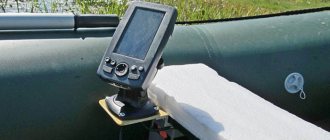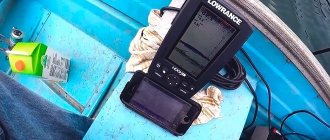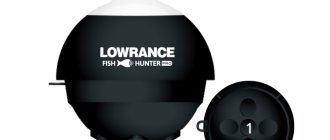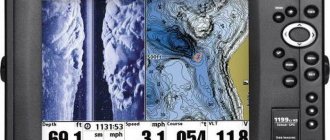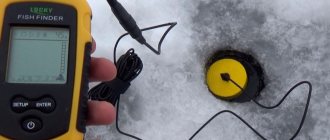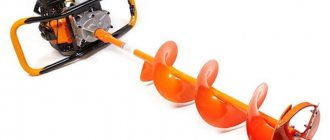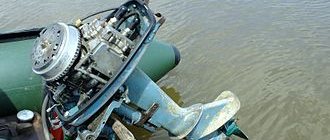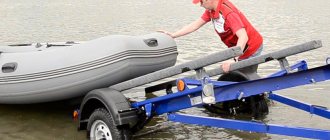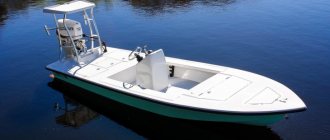Fishing has long been a well-known folk craft that helps people survive. If earlier fishermen used primitive fishing rods, today more gear and technical devices are available to make fishing easier.
Having at least one fishing rod and echo sounder in stock, the fisherman will definitely not be left without a catch and will be able to survive even in an emergency situation. Before purchasing, you should study how to choose, how to use, find out the features and technical characteristics of an echo sounder for fishing from a boat.
Using an echo sounder when fishing from a boat
For fishing to be effective, you need to carefully prepare for it. Different types of equipment and a fishing rod are half the success, but if the fisherman additionally uses an echo sounder, then the likelihood of a big catch increases several times.
This device is necessary for studying the bottom topography, which makes it easier to choose a place to place nets or use other devices. As a nice addition, the fish finder for boat fishing shows the presence of nearby fish and their size. With an echo sounder, it’s not scary to go to a new place, because with it you can literally “look” under the water and assess the current situation.
Note! It works not only in summer, but also in winter, providing a safe and fishing place under the wormwood.
There are many different options offered in stores, so you need to familiarize yourself with the functions and technical specifications.
Operating principle and structure of the echo sounder
An echo sounder is a device for determining the bottom topography. It is classified as a navigation system and was first used for military purposes, namely to identify enemy submarines. Today, the device has become widespread among fishermen and those who want to take a boat ride on unfamiliar bodies of water.
The device has some features that ensure its operation:
- frame;
- conversion crystal and transducer;
- antenna;
- display;
- control buttons;
- emitter;
- battery.
The operating principle of the echo sounder is based on the transmission of electrical impulses into the water. The emitter of these pulses is immersed in water: fixed to the hull of the boat, connected via a wire, and a radio beacon is launched.
The emitted waves, in turn, are converted into sound waves and, when they collide with an obstacle, return back, transmitting information to the display. Considering that the speed of sound in water is constant, the device accurately determines:
- Bottom topography (depressions or sharp protrusions).
- The location of the fish, its size or distance from the school.
Echo sounders send waves of different frequencies: a high one displays a clear image on the screen, but the study area is small. Low frequencies make it possible to view the current state underwater in general terms, because due to the noise that occurs, the picture is “blurred.”
The picture itself is a vertical scan, allowing you to study the depth of the reservoir and the position of the fish. Horizontal allows you to evaluate the changes that have occurred over a certain time.
How to fish with an echo sounder?
After turning on the echo sounder, the selection of settings occurs automatically, but sometimes manual adjustment may be required. In a shallow body of water, the most successful frequency is 192 Hertz. The viewing angle with this setting is 20–24 degrees.
Note! For a clear picture, the boat must move as slowly as possible. Objects located directly below your craft are displayed on the right side of the screen, and the bottom topography is displayed at the bottom of the display.
The simplest models indicate fish with an arc, and modern echo sounders determine where fish accumulate, and the size of the fish affects the clarity of the picture itself (the larger the better).
In order to work with an echo sounder effectively, it is necessary to determine personal convenient settings, as well as take into account the habits of the fish, which depend on its breed.
Of course, an echo sounder makes it easier to find fish in an unfamiliar body of water and “leads” the fisherman to good places, but does not hook him. Without high-quality equipment, bait and taking into account the time of day, it is unlikely that you will be able to catch fish.
Methods for attaching a sonar to a boat
There are several ways to attach a sonar to a boat:
- Fixing on the inner surface with epoxy glue is suitable for PVC boats, but there may be difficulties associated with measuring the depth and clarity of the picture on the screen.
- Mounting via bracket to transom. This method is available to slow-moving boats, and the design will protect against damage if obstacles are encountered along the way. This method can be considered the most convenient and accessible, but it cannot be used on a motor boat. The waves generated by the propellers create a lot of noise.
- Through mounting involves mounting the transducer to the bottom of the boat through a hole. This method eliminates interference and makes it possible to fully use the echo sounder in work.
What is an echo sounder for fishing?
The main elements of the device are a timer, a sound source and a microphone. If you purchased a modern model of fish finder, most likely, the microphone and timer will be enclosed in a common housing. A beam of a certain diameter emerges from the loudspeaker, which is directed to the bottom of the reservoir. The elementary laws of physics help you understand the principles of sonar operation. The beam is reflected from the bottom surface and returns to the device, where it is picked up by a microphone. A timer is used to record the time required to complete the process. If we assume that the speed of sound in the water column is 1,440 m/s, we can determine the depth of the reservoir and identify possible obstacles.
The key point in the operation of any echo sounder is detailed calculations. The device is equipped with a microcomputer that processes the received information and displays a visual image on the display. All operations with energy in the device occur at the expense of an artificial crystal. The diameter of the beam is directly related to its shape. Often, such devices use cylindrical crystals.
What types of echo sounders are there?
Echo sounders differ not only in the set of functions, but also in the principle of operation and the possibility of use in different conditions.
Portable
These are the simplest models that can be put in your jacket pocket. Working with them is simple: a small number of buttons does not give any chance of getting confused in the functionality.
The devices have proven themselves for fishing from the shore or in winter. The transducer easily withstands lower temperatures and does not distort the transmitted data in icy water. Can also be used for fishing from a boat.
The beam is weak, so it is not recommended to go to great depths to obtain accurate data. The old black and white screen significantly reduces power consumption, so an alkaline battery is enough to operate such models.
Stationary echo sounders
A stationary echo sounder for fishing from a boat is quite large and heavy, which prevents it from being used for traveling on foot, so it is used mainly on boats. Most models come standard with a foot for mounting the fish finder on board and the transducer on the transom.
Stationary devices for fishing from a boat are quite powerful and explore fresh water bodies to the bottom, regardless of depth. This is possible thanks to the built-in CHIRP transducer, which gradually changes the wave frequency from 80 to 160 kHz for the most accurate study of the bottom.
Echo sounders with GPS
Echo sounders with GPS are good because with the help of the device you can make a mark on the map about your favorite fishing spot. The fisherman will be able to mark several areas at once in order to return to them in the future. There are also echo sounders with a chartplotter, which have navigation and cartography indicating depth maps, bottom topography, and the presence of obstacles in the water.
What is an echo sounder
In the case of fishing, echo sounders are striking examples of the use of devices that were unavailable half a century ago.
The younger brothers of sonars that serve on submarines are successfully used by fishermen all over the world.
Let us recall that the principle of operation of the device is based on sending sound pulses, which, when reflected from objects, are a source of information about the distance to them.
The main tasks of echo sounders are to study the bottom topography and search for places where fish accumulate.
There is a fairly wide selection of models on the modern market (the most popular of them are presented at https://www.mfshop.ru/jekholoty/), which is due to the use of consoles in various conditions.
Typically, they can be divided into those intended for summer or winter fishing, for fishing from the shore or from a boat.
In addition, they may have a memory unit or operate only in online mode, and also have other useful properties, such as the Mark-5x Pro model from Lowranse, which determines the type of fish being sanitized.
Of course, the most advanced choice will be universal multibeam echo sounders, with many functions, including barometric sensors and GPS compatibility.
Choosing an echo sounder for fishing
Before choosing an echo sounder, the buyer studies not only the set of necessary functions, but also additional reviews from users.
Which company to choose an echo sounder
Each manufacturer strives to improve the performance of its products, but the set of functions may vary slightly.
Here are a few brands that offer us fish finders for fishing from a boat:
- Lowrance - equip their products with a wide range of additional functions. The controls are intuitive and the interface is in Russian. CHIRP technology allows one sensor to scan in several ranges at once.
- Humminbird is an American brand that has been on the market for more than 40 years and constantly pleases its customers with new fashionable additions (3D all-round view, SmartCast), which will be appreciated by advanced users. The manufacturer was one of the first among many competitors to offer waterproof devices to customers .
- Garmin are highly sensitive devices with an interesting design and a well-thought-out mounting system. They feature high-quality displays and powerful emitters.
- Deeper - produces high-quality wireless remote-controlled equipment. Accurate data is displayed regardless of the type of reservoir, that is, fresh or salt water.
- Praktik is a Russian company that sells easy-to-use, compact and functional echo sounders that remain operational even at low temperatures.
What to look for when choosing
The selected fish finder must have certain characteristics to ensure smooth and accurate operation:
- The strength of sound direction. The higher the power of the echo sounder, the clearer the picture will be displayed on the screen. The sensor detects the situation even at great depths. The power of the device is determined in watts.
- Receiver sensitivity. Devices with medium or adjustable sensitivity perform well. Highly sensitive instruments are necessary for catching small fish and analyzing the bottom.
- The frequency of the converter affects the quality of the resulting picture. Low frequencies (50 kHz) give a blurry picture but look deeper, while high frequencies (over 200 kHz) give an accurate picture but are unable to analyze greater depths.
- The size and contrast of the display affects ease of use. In sunny weather, a high-contrast display with a wide resolution will be visible, unlike the simplest black and white ones.
- The number of rays affects the quality of the picture. Budget ones are equipped with one beam, and the second beam on advanced models expands the viewing angle. Four or five beams are present only on professional echo sounders.
- Temperature, speed or side view sensors are a nice additional feature that allows you to monitor the current environment. Such additions are present mainly on expensive advanced models. The middle class is rarely equipped with them.
How much does an echo sounder cost?
The cost of the device directly depends on the functions. The more options available to the user, the higher the price.
Among the most affordable ones, which cost no more than 3-4 thousand, you can find good options, but you should not expect ultra-precision and unusual functions from the device.
Most of the “helpers” fall into the middle category, and the price ranges from 5 to 10 thousand rubles. The image displayed on the screen is clearer, and the information received is more accurate. A capacitive battery is also built-in.
A model for summer fishing on a small reservoir costs 4800–6000 rubles, and for winter fishing - 7 thousand rubles.
Expensive - 10–20 thousand rubles. These are the most high-frequency and accurate devices with a color display and capable of operating at great depths. They are suitable for spacious ponds. Some models are equipped with additional functions:
- enlarging the picture;
- sound notification;
- determination of fish size.
To troll on a boat, you need to buy professional echo sounders, the cost is from 60,000 to 170,000 rubles.
Deeper Pro
This model is more serious - it is suitable for fishing from the shore, and for fishing from a boat, and for ice fishing. Its technical characteristics are also noticeably better:
Wi-Fi reception distance: 100 m. Depth range: 50 cm - 80 m Number of beams: 2, 15° and 55° Dimensions of the detected object: 25 mm
When configured correctly (the application interface is intuitive, so fishermen do not have any difficulties), the device scans the bottom topography with high accuracy, recording schools of fish and individual fish, even small ones. Using free offline maps available in the application also makes fishing more comfortable. The price can also be included in the list of advantages - for a device of this level it is more than affordable.
There is exactly one significant disadvantage - there is no GPS for precise positioning via satellite.
Rating
There are different echo sounders available in stores. Even experienced fishermen, not to mention beginners, can get confused when faced with the question of which echo sounder to choose. However, among all the diversity, it is still possible to identify the most popular models, based on a review of echo sounders for fishing from a boat:
- The Humminbird PiranhaMAX 230 Portable is suitable for fishing from a boat or from the shore. The two-beam sensor “reads” information about the reservoir to a depth of 180 m, and the moisture-resistant housing ensures uninterrupted operation even in rainy weather, protecting equipment from exposure to water. The only drawback is the black and white display, but in the middle class (cost 11,000 rubles) it is considered the most reliable and accurate.
- Humminbird SmartCast RF35e. This model is a little simpler and is attached to the hand. The scanning range does not exceed 35 meters, and from the shore - only 22 meters, which significantly limits the fisherman. However, the price for the device is appropriate - 5 thousand rubles. Therefore, this is the best echo sounder for a beginner.
- JJ-connect Fisherman Wireless 3 Deluxe mobile portable echo sounder with a range of 40 m, beam angle 90 degrees. The display is not equipped with a mount, meaning it can only be held in the hands, which can complicate operation. Cost 5 thousand rubles.
- FishFinder ffw718 Wireless can be used from a boat or shore, as well as for winter fishing. It has a relatively small screen, but this disadvantage is offset by the advantages of the echo sounder. Radio signal range – 70 meters, drawing of the bottom topography, LED backlight, temperature sensor. The price of the device is 4,000 rubles.
- Fishfinder luckylaker ff916 - completes the rating of echo sounders with a device with a Wi-Fi function, that is, data from the emitter can be displayed on the smartphone screen (wireless range - 50 m). Depth – up to 45 m, coverage angle – 90 degrees.
Testing boat echo sounders (video)
Review on the topic: echo sounder functions
The above-mentioned world leaders in the production of echo sounders for fishing and navigation, as expected, have their advantages and disadvantages.
may pleasantly surprise you with the X-4 model echo sounder. This device has a 4-inch screen with fairly good resolution. The X-4 scanning depth is up to 180 meters. All standard functions are also present - alarm, bottom structure, fish depth.
An integral positive feature of this echo sounder is the quality of depth measurement and display of the bottom topography. The only drawback we can see is the lack of an arc mode. This makes it difficult to identify the fish and their location. The cost of this model ranges from 140 to 150 dollars. Unfortunately, I cannot offer analogues to this model.
Reviewing the model range with a price policy from 200 to 400 USD, we can offer wonderful echo sounders of the “Mark-5x” series, which have a number of advantages over the previous model: 5-inch screen, twice the resolution, four times increased black gradation -white shades, scanning in arc mode, which is very helpful in detecting the location of fish. The scanning depth of models in this series ranges from 76 to 305 meters, and the power ranges from 1600 to 4000 W. It is these advantages that determine such a difference in price.
Humminbird Fishfinder 525 and Humminbird Fishfinder 565
For about the same price it can offer you the Fishfinder 525, Fishfinder 565 and 717 models. But it should be taken into account that echo sounders benefit in image clarity, scanner power and design (it’s not for everyone).
If you are serious about fishing and can afford to spend $1,100, then we bring to your attention the Humminbird 748 3D three-dimensional echo sounder.
This is the most expensive echo sounder in our review, and its capabilities will amaze you: 6 beams that form a picture, thanks to which it is very easy to navigate the bottom topography and determine the location of the fish. The only thing that leaves much to be desired is the 5-inch screen, with the same resolution and color gradation.
Echo sounder care and operation
The device may seem primitive at first glance, but this does not negate the need to follow the operating rules.
Note! Close contact of the echo sounder does not guarantee its tightness. Water does not penetrate only into the signal emitter, and the housing does not guarantee protection of internal parts from water ingress.
Having taken the echo sounder out of the water, you need to wipe it with a towel, dry it and only then put it in the case.
Dirt is also unacceptable. A highly sensitive device may break if dirt particles get on the working elements. Therefore, after each use, the fisherman must clean it and remove dirt with a cloth.

